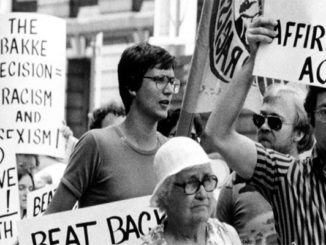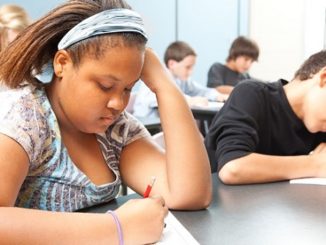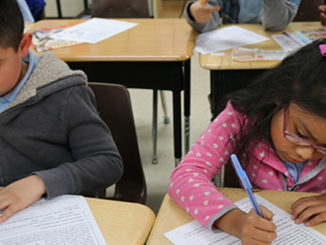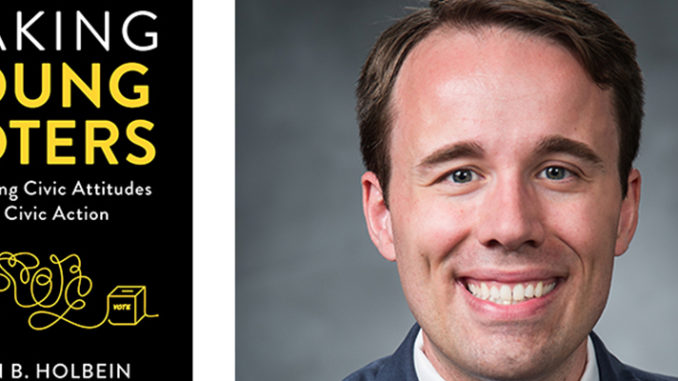
by Kevin Mahnken
This article was originally published at The 74.
How do you get America’s youngest voters to actually turn out on Election Day?
It’s a question that experts have asked for the past half-century, and one that may determine the outcome of the 2020 elections. Abundant survey data indicate that voters under the age of 40 don’t favor the prospect of a second term for President Trump, and many are attracted to the primary campaign of Sen. Bernie Sanders. Given that millennials have recently displaced baby boomers as the largest generation in the electorate, a decisive swing among young people could hand control of the federal government to Democrats this November.
Whether that’s likely is another question entirely. Yes, youth turnout hit record levels in the 2018 midterm elections. But that only meant that 1 out of every 3 eligible young voters exercised the franchise that year. As ever, they remain an enigma.
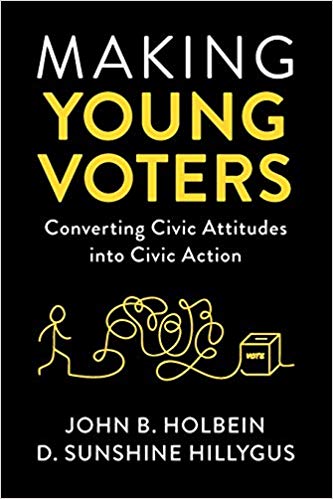 John Holbein is attempting to solve the mystery. An assistant professor of public policy at the University of Virginia, his research focuses on education and political participation. His new book with Duke University professor D. Sunshine Hillygus, Making Young Voters: Converting Civic Attitudes into Civic Action, will be released Thursday by Cambridge University Press.
John Holbein is attempting to solve the mystery. An assistant professor of public policy at the University of Virginia, his research focuses on education and political participation. His new book with Duke University professor D. Sunshine Hillygus, Making Young Voters: Converting Civic Attitudes into Civic Action, will be released Thursday by Cambridge University Press.
The hidden driver of low youth turnout isn’t a lack of political interest or motivation, Holbein and Hillygus write. It’s that the act of voting is “costly.” Citizens have to expend time and effort familiarizing themselves with candidates and policies, decide which they prefer, and then overcome life’s distractions long enough to find the right polling station on the right day (assuming they met the registration deadline, of course). It sounds simple enough, but for tens of millions of Americans, the abstract duties of democratic participation can only be considered after picking up the groceries.
When the media warn of a “civics education crisis,” they’re usually referring to the stream of new surveys showing that most adults can’t name a single Supreme Court justice. In Holbein and Hillygus’s view, though, the crisis goes deeper than that: Young people may know which policies they support and have every intention to vote but lack the wherewithal to follow through.
To counter that, they recommend that K-12 schools work to strengthen students’ non-cognitive skills — traits of thought and behavior that govern self-regulation and teamwork — to prepare them for the demands of citizenship. While Holbein and Hillygus acknowledge the importance of teaching American history and government, they also believe that kids will struggle to become responsible democratic actors if they don’t learn to overcome obstacles and treat others with respect.
“Even if lots of people could name their local elected official or accurately say who controls Congress, is that the type of knowledge that would help citizens be actively involved and informed about policy debates?” Holbein asked. “I don’t think so.”
This interview has been edited for length and clarity.
The 74: It’s well known that young people are the electorate’s least reliable voters. What, if anything, do K-12 schools have to do with that? Are they appreciably worse at preparing students for democratic participation, for instance, than for college? Or for the workforce?
John Holbein: One of the important things that should be taken away from our book is that we should be thinking about the civic outcomes that schools produce, and we should be thinking about them on par with the other outcomes.
All the focus over the past few decades seems to have been on test scores and college readiness, and part of me wants to say, “This has consequences.” It’s great to focus on those things, but it sort of crowds out the public mission of schools. If you go back into why public schools were made public in the first place, in large part it has to do with their capacity to make an electorate that is informed and engaged. We’re not doing that right now.
We don’t want to come down too hard on schools, because they face a lot of incentives to focus on other outcomes: increasing educational attainment and college-going, being a mechanism for reducing social inequities, and so on. But we can’t just ignore the civic effects. The way public policy has treated it in recent years, there’s been a sort of tension — we have to give up courses that would take away from reading and math. That comes with costs.
Has the rate of youth voting declined over time since the 1970s and ’80s? It certainly doesn’t seem to have risen.
It looks like it’s stagnated. There was a higher level of youth turnout in the ’70s. The tough thing about this is that for the period before the ’80s, it’s hard to get good data on voting by age and other demographics. My impression is that it was at a higher level — maybe 50 percent — in 1972, which was the first election after the voting age was changed to 18, and for subsequent presidential elections, we’ve been operating around 40 percent turnout for young voters. There was a decline through the ’70s to the level that it’s been for the last 30 or 40 years.
But voter enthusiasm has been higher in recent elections, right? It seems like this era of hyper-partisanship and constant political news has driven higher voting rates in recent years.
Yes, but we’ll see if it lasts. The last time we saw a similar spike in youth participation was 2008 and the Obama campaign. And it’s sad to say, but by the next presidential election, we were already down almost 10 percentage points from that. A good chunk of those young voters who turned out in 2008 are older now, and the young citizens who are replacing them aren’t necessarily turning out at the same rates.
If you think about the types of political participation that many people engage in, it’s online discourse: debating politics on Twitter or posting about some political issue on Facebook. And it’s not clear that those actions actually translate to the types of political power that we want people to use: at the ballot box, but also in local community organizing, registering and canvasing to get out the vote.
We have a little evidence that suggests that elected officials view social media engagement sort of warily. At least, they think that if they can weather the storm when bad press comes — a school shooting or a climate march — they’re in the clear. Whereas if we think about the types of engagement that actually pressure elected officials, it’s who turns out to vote, who writes their members of Congress. They’re labor-intensive, difficult forms of political action.
I have a working paper under review right now looking at whether or not there’s a spike in voter registration after school shootings, and whether those shootings shape political participation. What we find is that there’s a massive spike that jibes with what we see online; if you’re looking at Google Trends data or Twitter topics, there will be big spikes after school shootings that, subsequently, turn into discussions about gun control. But then, two weeks later, that’s gone, and sadly, nobody in the interim has said, “Hey, let’s register to vote!” Political events come and go, but I’m not sure they’re enough to mobilize young citizens in a durable way that will make them active caretakers of democracy, as the Founders envisioned.
There are reasons for optimism. I don’t think it’s bad that people are engaged on social media. But the story can’t be, “All is well.”
We’ve been talking a lot about voting, voter registration, voter turnout — the theme of your book is how to get young people to vote — but there are other valuable forms of democratic action. There’s volunteering, donating to campaigns, attending meetings of local government bodies. Why focus on voting specifically?
Many of the findings in our book about voting actually hold up for volunteering as well. The book focuses on voting because it’s the primary mechanism for the transfer of political power in the United States. But we’re finding that the lessons we’ve talked about are true in other domains. Going to the polls, showing up to volunteer in your community, attending a community meeting — those are acts that require time and energy. They’re not “free” in that sense. Young people have a notion that they should be doing these things, that these activities are part of being a good citizen, but when the rubber hits the road, they often fail to follow through.
Young people who are exposed to a traditional civics education — the kind of vanilla, fact-focused distillation of politics and government and American history — are no more likely to volunteer than their peers who get less of that. It’s also true that if you teach young people to follow through on their good intentions, give them the non-cognitive skills they need to set a plan and execute it, that will yield more volunteering.
We don’t want to say, by any means, that the only thing civics should be doing is producing voters. It should be voting and being knowledgeable about politics, being tolerant toward those with opposing views, being active in one’s community and civic life.
You mentioned the importance of non-cognitive skills in making engaged citizens, which is the centerpiece of your book. Most people think that the main problem in civics education is a lack of knowledge, typified by annual surveys showing that most Americans can’t name Supreme Court justices or list the rights enumerated in the First Amendment.
Yeah. The people who think Judge Judy is a member of the Supreme Court.
But you seem to be saying that the core problem in civics education isn’t really the lack of factual knowledge about government and politics. Can you elaborate?
Civic knowledge is necessary but not sufficient. Young people need to know certain things, but if civic education is exclusively that, that’s where there’s trouble. Even if lots of people could name their local elected official or accurately say who controls Congress — is that the type of knowledge that would help citizens be actively involved and informed about policy debates? I don’t think so.
What’s underlying this book is an argument against focusing narrowly on the types of things that are easy to measure and that have been part of the fabric of civic education for a long time. If you think of the things that young people need to know to be engaged, it’s actually the mechanical stuff about how to be involved in politics. It’s knowing when you have to register and how that process works. It’s knowing when, where and how you can vote. And of course, we also want them to know about the issues at hand, and where elected leaders stand on those issues. If you unravel the set of things we want young people to know, they’re really not addressed in most civics education courses.
As part of our data collection, we interviewed civics teachers and said, “OK, what are you doing?” They mostly said they were following the classic civics model: teaching people about the Constitution, the Founding Fathers, etc., and not really talking so much about the mechanics of political engagement today and what’s going on in the world around us. One of the reasons they cited was that many teachers feel that if they were to delve into these topics, they’d face a backlash from parents. In a polarized environment, they worried that talking about LGBTQ issues or climate change or gun policy would earn them a nasty email from parents to the school board. There’s a real hesitance to teach the things that are necessary for people to know if they’re going to take part in democracy.
It’s a tricky problem to balance the incentives of civic education such that we’re producing knowledgeable citizens but doing so in a way that teachers don’t fear losing their jobs.
Let’s return to the subject of non-cognitive skills. When we talk about the obstacles people face when voting, we usually start with suppressive measures like voter ID laws and voter purges. After that, you run into the lack of civic knowledge or inclinations — people don’t know who’s running for office, and they might not care. But Making Young Voters postulates that, even if people know whom they want to vote for and are not procedurally barred from voting, they often still don’t vote. How do you explain that?
I want to be careful here. We do think those obstacles matter, and we show that young people are especially sensitive to how hard it is to register to vote, for instance. But we should also acknowledge that, in addition to these external or institutional challenges, people also have lives. Voting’s not so different from a lot of the other types of human behaviors that we feel like we should do but often don’t, even when it’s really easy.
This is a silly example, but it illustrates the point: I put a treadmill in my basement so I would get more exercise. I literally made it as easy as possible to exercise. The costs are basically zero, just walking down the stairs. But sometimes I still don’t use it, and not because of external forces. It’s because life is busy and complicated. Your kids get sick, or you’ve got a big project at work, you get overwhelmed, and what falls by the wayside are the types of things that we feel we should do, but don’t have the energy to do.
In the case of voting, yes, institutional obstacles matter, and yes, we need to make voting and registration easier. But if that’s all we focus on, we’re going to miss a huge slice of the population that is interested in politics, cares about politics, sees voting as important, but doesn’t do it because they don’t have the preparation or capacity to follow through.
We could make voting easier, and we could increase people’s knowledge about politics, but we should also think about teaching the next generation that when obstacles get in the way, you keep going. Even if it’s difficult and hard, and they’re tired, they keep going, such that they can achieve their goal of participating in politics.
I’ve been drawn to this idea since writing about a study you published with Professor Hillygus in 2018. The main finding was that kids who showed efficacy and self-belief — who saw themselves as able to persevere through challenges — were also more likely to say they intended to vote later in life. That paper followed earlier research you conducted on disadvantaged students who were exposed to the Fast Track program, which specifically aims to teach kids grit, problem-solving and emotional regulation. In their 20s, those kids were between 7 and 9 percent more likely to vote.
But as interesting as those findings are, they raise questions: Can we really expect most schools to inculcate kids with civics skills?
I think the answer is yes, and it’s possible to do it earlier than we do now.
First, a general focus on non-cognitive development — even outside a civics framework — actually has payoffs in terms of civics. Because you’ve taught students to do things that they’d need to do in politics. By teaching kids to interact well in the classroom, to work with their peers, to not be hostile toward other people, you’re teaching skills that are really useful in a democracy!
But there are really specific applications as well. We write a lot in the book about the Democracy Prep charter schools. That’s a network that pushes groups of students to do things together — it’s teaching them how to solve problems in their community, how to mobilize other citizens. They’re essentially saying, “We’re dealing with individuals who aren’t necessarily old enough to vote. How do we get them practicing and developing the skills they need to work with others and overcome challenges?”
You can integrate non-cognitive development across classrooms, not just in civics. We put a lot of pressure on civics, but the public mission of schools wasn’t intended to be explored in just one academic course. As Horace Mann conceived it, it was meant to be a holistic, fully immersive educational experience.
Let’s get even more specific. How can we equip schools to build non-cognitive skills in kids? Is it through programs like Fast Track, for instance?
I think that’s one part of it. A lot of these programs take time out of the classroom, but they’re not necessarily taking hours each day. For really young kids, you’re setting aside time to build capacities that they might not otherwise pick up. It’s really important to have time for kids to think about their lives and consider how they will face obstacles or social difficulties at school. That’s very valuable.
As children get older, it’s a little trickier, because there hasn’t been a lot of research into what [social-emotional education] looks like in middle and high school. But we should consider how to engage teenagers in thinking about how they might work with other people. I’m not advocating for Fast Track as the be-all, end-all program, but I think it’s right that there should be some portion of the school day focused on the development of skills that aren’t picked up by standardized tests.
What that looks like, and how much time gets used, I’m not sure. It should be up to schools to tinker and experiment on those decisions. But it’s definitely worthwhile to think about teaching kids perseverance, empathy, problem-solving. Again, there’s lots to be learned from Democracy Prep: They’re having kids choose a social problem in their community. The kids work together, and they realize that their plan for dealing with that problem won’t just come together easily.
The lesson is that we need to allocate time in the day for developing and fostering these non-cognitive skills. The payoffs go way beyond academics, or what we see in the labor force.
Democracy Prep is an example of a network that probably couldn’t do more than it’s already doing to build civic engagement. Kids have to pass the U.S. citizenship to graduate eighth grade. They participate in get-out-the-vote drives even as third- and fourth-graders. They complete year-long senior projects to address social problems in their communities.
This is a model that can’t be replicated wholesale in every school in the country, and while they’re doing a good job getting graduates to participate in democracy — one study found that their alumnae are 12 percentage points more likely to vote — the returns are finite. Have you thought about what lessons the average school can learn from a program like that?
That’s right. Democracy Prep is unique in that it builds civics instruction into everything it does. But when you look down the spectrum, there are lower-cost interventions in civics that work.
In the book, we cite a study that tested the effect of a one-time, in-classroom voting demonstration. The author set up a voting booth in a classroom, took in voter registration forms, explained the process and gave a 45-minute presentation about the particulars of voting. She showed, with a pretty incredible research design, that that had significant effects on young people’s later rates of voting.
I totally get that the capacity of schools to implement some of these ideas is going to vary. But we do have some evidence that, even if we go down to a lower-level intervention that really gets into the practical details of how, when, where and why to vote — that helps. My view is that anything schools can do to move from the traditional, bland civics education approach to a more applied, active learning environment, that’s going to help. As you do more, it’ll probably have larger effects.
There are diminishing returns when you’re trying to close the age gap in voting. At a certain point, you’ve done all you can from an educational perspective, and you’re bumping up against some of the structural issues we have in the United States. The same is true for the black-white achievement gap: Even if we implemented all the reforms that we know are effective, would they work? By the same token, we can go a long way toward the goal of increasing youth turnout; we might not get all the way there because of poverty, or institutional racism, but we can still get part of the way.
The point is that it doesn’t have to be Democracy Prep or bust. The things that schools should be thinking about are applied, active learning, giving young people the resources to help them vote and providing information that’s relevant to today rather than 200 years ago.
But at the same time, there’s a danger in active civics instruction that you alluded to earlier. Many parents are wary, and perhaps justifiably so, of their kids being indoctrinated. There’s a difference between teaching kids about the Constitutional Convention of 1787 and engaging them in discussions of live political issues in 2020.
Is there a danger of students forming political identities in school? And do you think the very perception of that danger is, itself, an impediment to schools devoting more time and resources to civics?
This is really tricky. I’m imagining a superintendent somewhere reading our book and asking, “How do I do this in a way that doesn’t just become overtly partisan?” And there are voices on both sides who would say that it should be overtly partisan. Some people undoubtedly think that civics education isn’t being done right unless we’re teaching young people to fight against the forces that brought us Donald Trump. On the flip side, you’ve got people saying that civics education isn’t being done right unless you’re talking about patriotism.
That’s probably a whole other book. But one of the things we found in our research was that interventions to build non-cognitive skills don’t necessarily change people’s political attitudes. It’s a really interesting non-effect. The Fast Track program, for example, increased voter participation significantly — without influencing whether people registered as Democrats or Republicans.
It’s worthwhile for educators to wade into the muck and figure out how to do these types of active learning in a way that enhances public virtues that transfer across the ideological spectrum. We want schools to establish the values and skills that we all agree are important: compassion, selflessness, hard work and determination.
There’s got to be some thought about how to do this in an environment where parents get upset over school mandates. These initiatives have to be shaped in ways that take into account parents’ values and perspectives because it’s not just schools that are developing these non-cognitive skills. We know from economic and child development research that families play a key role in developing kids’ non-cognitive abilities. So there should be a level of interaction between schools and the home in cultivating skills that will help kids build communities, whether they’re Republicans or Democrats.
This is actually the ideal of education: confronting difficult ideas and allowing people the freedom to do so in the way they choose, yet forcing them to engage. But I don’t think the current status quo — where we just resort to boring, inoffensive civics to avoid controversial topics — is workable.
A few communities have already lowered the voting age in local elections to 16. Presidential candidate Andrew Yang has recommended that the same be done in federal elections. What’s your stance?
The big challenge here is that this move is generally restricted to municipal elections. We tried to do a study for the book looking at the few towns that lowered their voting age, and the problem they’re facing is that not many 16- and 17-year-olds are taking advantage of this right in municipal elections. Rates of voter participation are so low in these off-cycle, odd-year elections for mayor and school board.
I’m just not optimistic that, even if everybody did it, it would make a big impact. It’s one thing to give younger kids the right; the key mechanism, however, is actually using it and learning how it works. Until there’s a resolution to go beyond low-turnout municipal elections, I’m just a little skeptical that lowering the voting age will have the effects we might want.
Yes, it’s a pretty low-cost way of trying to do better. But if you think about the ideal system, it’s one that automatically registers or pre-registers young people at school, reminds them of when the voting process is happening and builds in steps along the way to create the kind of interaction that happens in federal elections. I don’t want to sound like a Debbie Downer, but it’s a real difficulty when we’re relying so heavily on local elections where not a lot of people vote.

